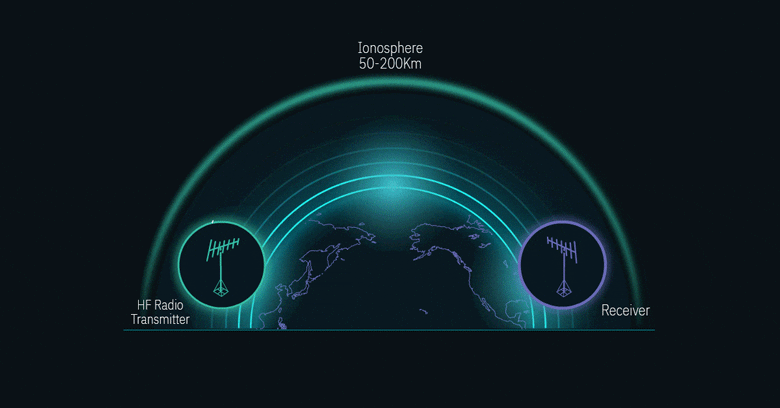The Basics of HF Data Networks
High Frequency, radio-based, intercontinental ultra-low latency data network. The 101.
Wireless beats fiber
The quest for faster networks is aiming for the ultimate speed of light.
We’re getting close.
Light travels 50% faster through air than through glass – like in a fiber optic cable.
Radio frequency travels through air at the same speed of light through air.
This physical phenomenon grants a wireless radio-based network with a potential advantage over fiber of 1ms per every 1000Km of travel.
Microwave beats fiber over land (seen the hummingbird project?).
Microwave network operates only on land, as a clear line of site is required between antennas placed every 50km or so. It is simply not practical to stretch MW links over long distances.
Long distance wireless
Raft harnesses radio frequency Skywaves to transmit data signals across long distances, on land or over sea.
Skywaves, a known phenomenon of HF or High Frequency radio, are propagated back from the atmosphere which acts as a mirror, hence can travel long – intercontinental distances.
On top of the difference in light speed (through air vs in fiber), a Skywave based signal’s travel distance is also shorter compared with other alternatives, even when the signal may “hop” between earth and the ionosphere (50-200Km in altitude) every 3000Km or so. This additional speed advantage is product of the signal traveling the shortest path between any two points – on the geodesic line (of a circle – the globe), something a fiber link can’t do.

It is possible to send signals between say, NY and Tokyo (10,800Km apart), using only two large HF antennas. The bandwidth is small – only a several bits – but it will arrive with the lowest latency ever.
It’s a big deal
Transmitting data at the fastest speed possible requires careful optimization of every component of the system, including site selection, the ant. (antenna), modem, amplifier, error correction algorithms, as well as clever link management making it most useful, available, and stable.
This is the challenge we face.
It’s why we are here, at Raft.
Pushing the limits, devising ways to be a bit faster, the fastest.
What can you expect from such unique low latency data network that is faster than your current alternative?
Well, it is different in quite a few ways.
- An HF link is unidirectional, so a CHI-TOK is only one way. To transmit TOK-CHI we’d need another set of antennas and dedicated equipment - another link.
- A message is comprised of several bits. This means that you’d be limited to a limited “words” vocabulary in your messaging, so only indicators are usually transferred, rather than raw data stream.
- Frequency – the number of messages transmitted per second. A good reference range is a few hundreds, depending primarily on distance.
- Throughput (TP), the percentage of successfully passing indicators, is not a 100 percent - by design. Guaranteeing a 100 percent throughput would cost time, which we are reluctant to pay. So, whatever gets there fast is welcome. With good link management, TP could be as high as 80-90 percent over time.
- Errors – once again, a tradeoff with speed. The idea is to achieve as low an error rate as possible while avoiding “holding” the signal for any time-consuming error correction mechanism. We were able to reduce detection errors to a negligible level (reading “B” when “A” was sent), and false positive errors (reading “B” when nothing was sent) can be measured a few times per day. FP errors are closely monitored as these could be acute, depending on what the “B” indicator signifies.
- Availability – the number of hours a day you can get an HF link to work consistently with decent TP and close to zero FP errors. It’s an art, and we’re getting better at it every day. You can currently expect a decent coverage during the day (not 24h as of yet), while also becoming accustomed to another unique feature of HF data networks – seasonality. Changes in day/night hours spread over the local times of distant cities have an impact on availability
But hey, unlike MW, HF is weather independent.
We’re happy to discuss further.
Thanks for your attention,
The team at Raft.